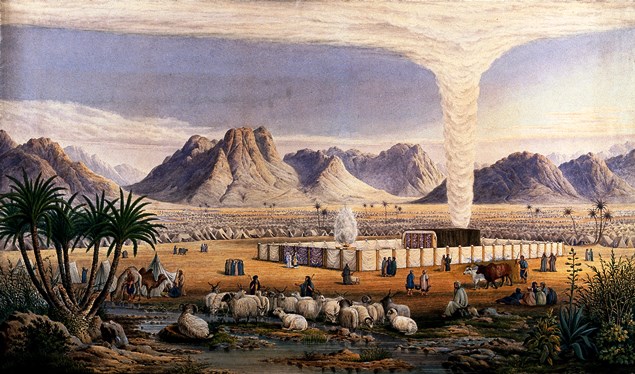(3-4 Minute Read)
Exodus 38:21 – 40:38
Pekudei begins with the orders [or records] of the Mishkan, Tabernacle, which were drawn up at Moses’ instruction by the Levites under the supervision of Itamar, the son of Aaron the priest. Bezalel along with Oholoiab had constructed and created all that the Almighty had commanded through Moses.
The amount of various materials used for the Tabernacle included 29 talents (or 730 shekels) of gold; 100 talents (or 1,775 shekels) of silver; a half-shekel donation of silver per male over the age of 20 years old, representing a total of 603,550 men; and 70 talents (or 2,400 shekels) of copper.
The vestments of the priests were also made of the fine materials, exactly as the Most High had specified. These included the ephod, the shoulder pieces, the breastplate, the robe, the tunics, and the headdress along with the frontlet inscribed with the phrase, “Holy to the Almighty.”
Thus all the work of the Tabernacle [and the affiliated items and vestments] was completed. The Israelites did exactly as the Most High had commanded them. They brought the Tabernacle, etc., to Moses. When Moses saw the completed work done precisely as the Eternal One specified, he blessed them.
The Almighty spoke to Moses, telling him to set up the Tabernacle on the first day of the first month. The Most High reiterated how to set up the Tabernacle and the various items thereof, including the Ark of the Pact [Covenant], the curtain [of the Holy of Holies], the table of the bread of display, the lampstand, the altar of incense, the screen for the entrance to the Tabernacle, the altar of burnt offerings, the copper laver [of washing water], the outer enclosure, and more. The Tabernacle and everything thereof — even the utensils — were to be anointed with the sacred oil and thereby consecrated.
Aaron and his sons were to be brought forward to the entrance of the Tabernacle, washed with water, dressed in the priestly vestments, and anointed with sacred oil. This anointing and consecration would establish them as the everlasting priesthood throughout the ages.
In the first month of the second year [from their departure from Egypt] Moses set up the Tabernacle. In all categories of the Tabernacle Moses did exactly as he was commanded by the Eternal One.
When Moses had finished, the cloud of the Glorious Presence of the Most High settled on the Tabernacle, and he could not enter the Tabernacle [i.e. the Holy of Holies]. When the cloud of the Glorious Presence lifted, the Israelites would depart on their various journeys; when the Glorious Presence remained, so did they. The cloud of the Glorious Presence of the Almighty rested on the Tabernacle by day, and appeared as a pillar of fire by night, in the view of all the community of Israel throughout their journeys.

It has been asked why the Torah narrative regarding the construction of the Tabernacle seems to some to be very redundant in content. After all, we just read the fine technical details of every item of the Tabernacle in the previous Torah portions. So why do we need to mention them all again as the Tabernacle was being constructed? One idea stems from the phrase “and he / they did exactly as the Almighty commanded” that occurs all throughout the Torah portions of Vayakhel and Pekudei. Observing the Torah requires an immense attention to detail. When it comes to keeping mitzvot, it is sometimes tempting to merely shrug and say, “Good enough.” However, the construction of the Tabernacle indicates that the details do matter, especially to the Most High. While some aspects of the Torah and the observance thereof may seem excessively detailed and tedious, the Almighty indicates that this attention to detail is necessary. However, when we are scrupulous to follow the Torah to the letter and carefully heed even the minute details, the Eternal One is immensely pleased and even boasts about it, if you will. Thus, much of these two Torah portions is essentially the Most High proudly boasting that His people carefully followed His every commandment. The Almighty could have instructed Moses to merely write something like “Bezalel and the Israelites constructed the Tabernacle in the proper way.” Instead, the Most High gave His people the same level of complementary attention in the Torah that they gave to the proper construction of the Tabernacle — their “apparatus” for achieving the highest possible connection with Him.
May the Holy One, Blessed be He, continue to provide us with the details on how best to follow the Torah and have a relationship with Him and those close to us. And may we ever be mindful of the details of our observance of the Torah and our connection with the Holy One, Blessed be He, understanding how much He appreciates these scrupulous efforts.


